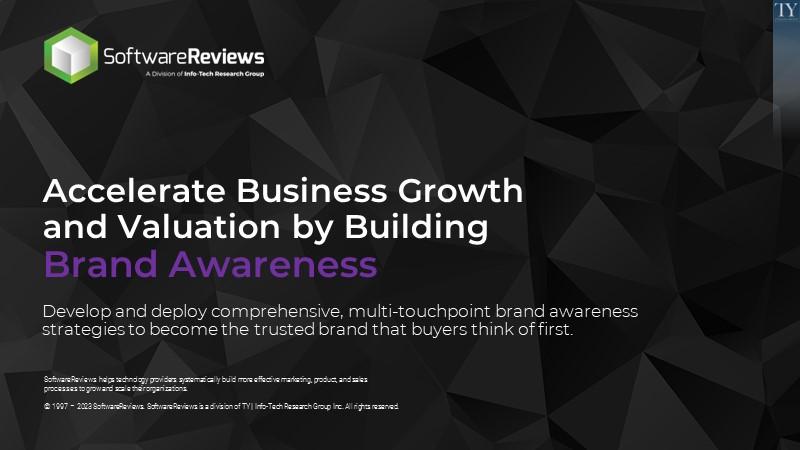
Accelerate Business Growth and Valuation by Building Brand Awareness
Brands that fail to invest in brand awareness are likely to face some, if not all these problems:
- Lack of brand visibility and recognition
- Inability to reach and engage with the buyers
- Difficulties generating and converting leads
- Low customer retention rate
- Inability to justify higher pricing
- Limited brand equity, business valuation, and sustainability
Our Advice
Critical Insight
Awareness brings visibility and traction to brands, which is essential in taking the market leadership position and becoming the trusted brand that buyers think of first.
Brand awareness also significantly contributes to increasing brand equity, market valuation, and business sustainability.
Impact and Result
Building brand awareness allows for the increase of:
- Brand visibility, perception, recognition, and reputation
- Interactions and engagement with the target audience
- Digital advertising performance and ROI
- Conversion rates and sales wins
- Revenue and profitability
- Market share & share of voice (SOV)
- Talents, partners, and investors attraction and retention
- Brand equity, business growth, and market valuation
Accelerate Business Growth and Valuation by Building Brand Awareness Research & Tools
Besides the small introduction, subscribers and consulting clients within this management domain have access to:
1. Accelerate Business Growth and Valuation by Building Brand Awareness Storyboard - Learn how to establish the brand foundation, create assets and workflows, and deploy effective brand awareness strategies and tactics.
A two-step approach to building brand awareness, starting with defining the brand foundations and then implementing effective brand awareness strategies and tactics.
- Accelerate Business Growth and Valuation by Building Brand Awareness Storyboard
2. Define Brand's Personality and Message - Analyze your target market and develop key elements of your brand guidelines.
With this set of tools, you will be able to capture and analyze your target market, your buyers and their journeys, define your brand's values, personality, and voice, and develop all the key elements of your brand guidelines to enable people within your organization and external resources to build a consistent and recognizable image across all assets and platforms.
- Market Analysis Template
- Brand Recognition Survey and Interview Questionnaire and List Template
- External and Internal Factors Analysis Template
- Buyer Personas and Journey Presentation Template
- Brand Purpose, Mission, Vision, and Values Template
- Brand Value Proposition and Positioning Statement
- Brand Voice Guidelines Template
- Writing Style Guide Template
- Brand Messaging Template
- Writer Checklist
3. Start Building Brand Awareness - Achieve strategic alignment.
These tools will allow you to achieve strategic alignment and readiness, create assets and workflows, deploy tactics, establish Key Performance Indicators (KPIs), and monitor and optimize your strategy on an ongoing basis.
- Brand Awareness Strategy and Tactics Template
- Asset Creation and Management List
- Campaign Workflows Template
- Brand Awareness Strategy Rollout Plan Template
- Survey Emails Best Practices Guidelines
Infographic
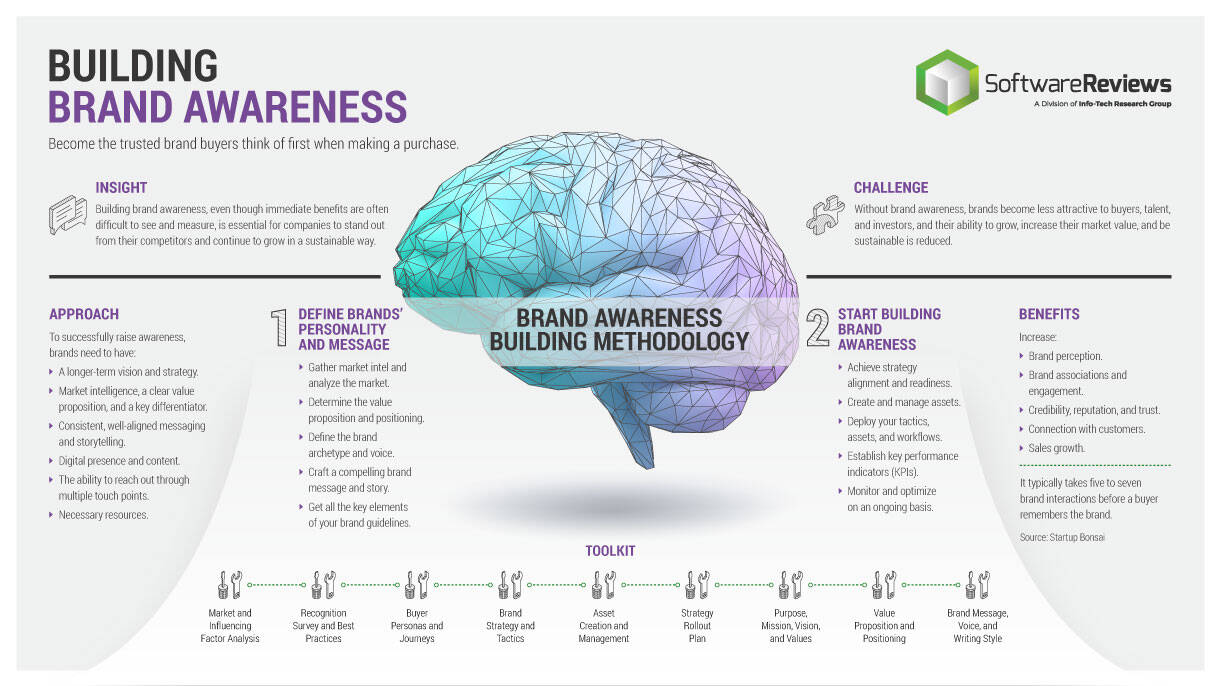
Further reading
Accelerate Business Growth and Valuation By Building Brand Awareness
Develop and deploy comprehensive, multi-touchpoint brand awareness strategies to become the trusted brand that buyers think of first.
EXECUTIVE BRIEF
Analyst perspective
Building brand awareness
Achieving high brand awareness in a given market and becoming the benchmark for buyers
is what every brand wants to achieve, as it is a guarantee of success. Building brand awareness,
even though its immediate benefits are often difficult to see and measure, is essential for companies that want to stand out from their competitors and continue to grow in a sustainable way. The return on investment (ROI) may take longer, but the benefits are also greater than those achieved through short-term initiatives with the expectation of immediate, albeit often limited, results.
Brands that are familiar to their target market have greater credibility, generate more sales,
and have a more loyal customer base. CMOs that successfully execute brand awareness programs
build brand equity and grow company valuation.

Nathalie Vezina
Marketing Research Director
SoftwareReviews Advisory
Executive summary
Brand leaders know that brand awareness is essential to the success of all marketing and sales activities. Brands that fail to invest in brand awareness are likely to face some, if not all these problems:
- Lack of brand visibility and compelling storytelling.
- Inability to reach the target audience.
- Low engagement on digital platforms and with ads.
- Difficulties generating and converting leads, or closing/winning sales/deals, and facing a high cost per acquisition.
- Low/no interest or brand recognition, trust level, and customer retention rate.
- Inability to justify higher pricing.
Convincing stakeholders of the benefits of strong brand awareness can be difficult when the positive outcomes are hard to quantify, and the return on investment (ROI) is often long-term. Among the many obstacles brand leaders must overcome are:
- Lack of longer-term corporate vision, focusing all efforts and resources on short-term growth strategies for a quick ROI.
- Insufficient market and target buyers' information and understanding of the brand's key differentiator.
- Misalignment of brand message, and difficulties creating compelling content that resonates with the target audience, generates interest, and keeps them engaged.
- Limited or no resources dedicated to the development of the brand.
Inspired by top-performing businesses and best practices, this blueprint provides the guidance and tools needed to successfully build awareness and help businesses grow. By following these guidelines, brand leaders can expect to:
- Gain market intelligence and a clear understanding of the buyer's needs, your competitive advantage, and key differentiator.
- Develop a clear and compelling value proposition and a human-centric brand messaging driven by the brand's values.
- Increase online presence and brand awareness to attract and engage with buyers.
- Develop a long-term brand strategy and execution plan.
"A brand is the set of expectations, memories, stories, and relationships that, taken together, account for a consumer's decision to choose one product or service over another."
– Seth Godin
What is brand awareness?
The act of making a brand visible and memorable.
Brand awareness is the degree to which buyers are familiar with and recognize the attributes and image of a particular brand, product, or service. The higher the level of awareness, the more likely the brand is to come into play when a target audience enters the " buying consideration" phase of the buyer's journey.
Brand awareness also plays an important role in building equity and increasing business valuation. Brands that are familiar to their target market have greater credibility, drive more sales and have a more loyal customer base.
Building brand awareness allows increasing:
- Brand visibility, perception, recognition, and reputation
- Interactions and engagement with the target audience
- Digital advertising performance and ROI
- Conversion rates and sales wins
- Revenue and profitability
- Market share and share of voice (SOV)
- Talents, partners, and investors attraction and retention
- Brand equity, business growth, and market valuation
"Products are made in a factory, but brands are created in the mind."
Source: Walter Landor
Capitalizing on a powerful brand
A longer-term approach for an increased and more sustainable ROI.
Market leader position
Developing brand awareness is essential to increase the visibility and traction of a brand.
Several factors may cause a brand to be not well-known. One reason might be that the brand recently launched, such as a startup. Another reason could be that the brand has rebranded or entered a new market.
To become the trusted brand that buyers think of first in their target markets, it is critical for these brands to develop and deploy comprehensive, multi-touchpoint brand awareness strategies.
A relationship leading to loyalty
A longer-term brand awareness strategy helps build a strong relationship between the brand and the buyer, fostering a lasting and rewarding alliance.
It also enables brands to reach and engage with their target audience effectively by using compelling storytelling and meaningful content.
Adopting a more human-centric approach and emphasizing shared values makes the brand more attractive to buyers and can drive sales and gain loyalty.
Sustainable business growth
For brands that are not well established in their target market, short-term tactics that focus on immediate benefits can be ineffective. In contrast, long-term brand awareness strategies provide a more sustainable ROI (return on investment).
Investing in building brand awareness can impact a business's ability to interact with its target audience, generate leads, and increase sales. Moreover, it can significantly contribute to boosting the business's brand equity and market valuation.
"Quick wins may work in the short term, but they're not an ideal substitute for long-term tactics and continued success."
Source: Forbes
Impacts of low brand awareness on businesses
Unfamiliar brands, despite their strong potential, won't thrive unless they invest in their notoriety.
Brands that choose not to invest in longer-term awareness strategies and rely solely on short-term growth tactics in hopes of an immediate gain will see their ability to grow diminished and their longevity reduced due to a lack of market presence and recognition.
Symptoms of a weakening brand include:
- High marketing spending and limited result
- Low market share or penetration
- Low sales, revenue, and gross margin
- Weak renewal rate, customer retention, and loyalty
- Difficulties delivering on the brand promise, low/no trust in the brand
- Limited brand equity, business valuation, and sustainability
- Unattractive brand to partners and investors
"Your brand is the single most important investment you can make in your business."
Source: Steve Forbes
Most common obstacles to increasing brand awareness
Successfully building brand awareness requires careful preparation and planning.
- Limited market intelligence
- Unclear competitive advantage/key differentiator
- Misaligned and inconsistent messaging and storytelling
- Lack of long-term vision
- and low prioritization
- Limited resources to develop and execute brand awareness building tactics
- Unattractive content that does not resonate, generates little or no interest and engagement
Investing in the notoriety of the brand
Become the top-of-mind brand in your target market.
To stand out, be recognized by their target audience, and become major players in their industry, brands must adopt a winning strategy that includes the following elements:
- In-depth knowledge and understanding of the market and audience
- Strengthening digital presence and activities
- Creating and publishing content relevant to the target audience
- Reaching out through multiple touchpoints
- Using a more human-centric approach
- Ensure consistency in all aspects of the brand, across all media and channels
How far are you from being the brand buyers think of first in your target market?
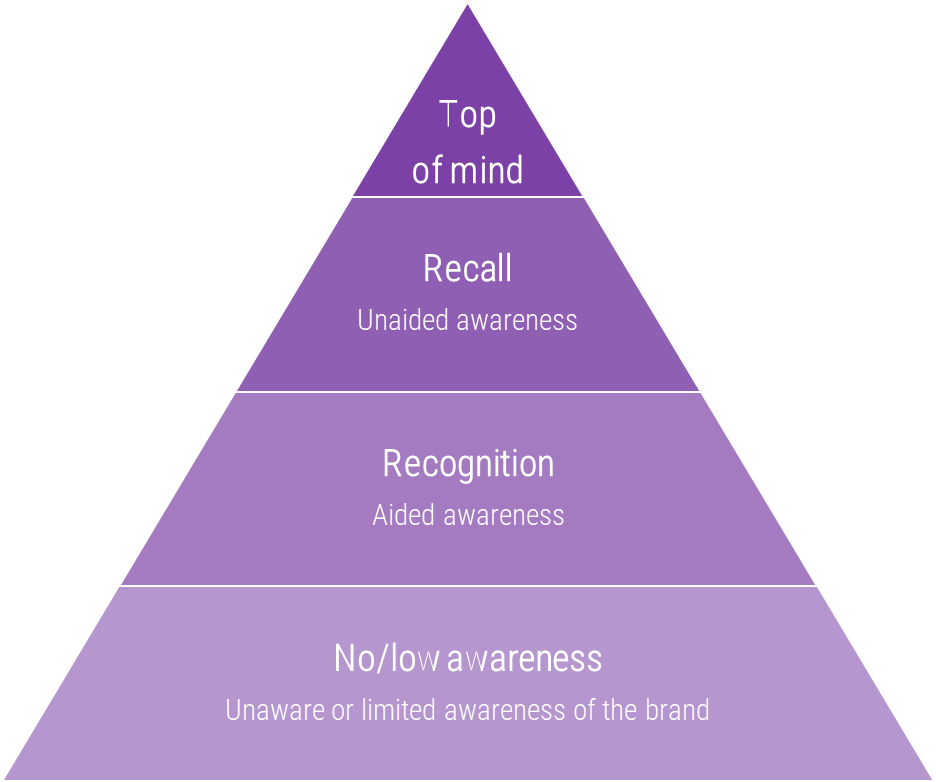
Brand awareness pyramid
Based on David Aaker's brand loyalty pyramid
Tactics for building brand awareness
Focus on effective ways to gain brand recognition in the minds of buyers.
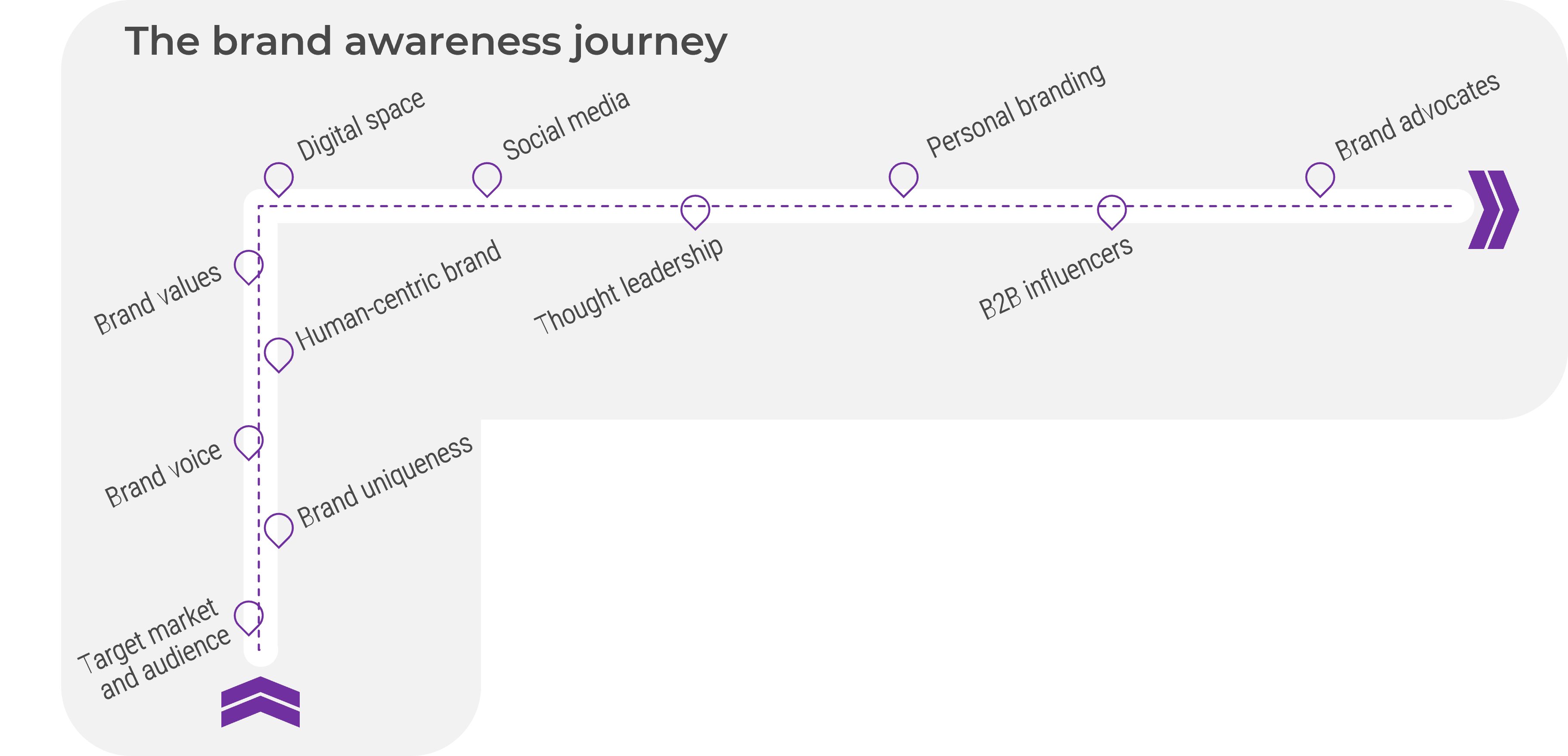
Brand recognition requires in-depth knowledge of the target market, the creation of strong brand attributes, and increased presence and visibility.
Understand the market and audience you're targeting
Be prepared. Act smart.
To implement a winning brand awareness-building strategy, you must:
- Be aware of your competitor's strengths and weaknesses, as well as yours.
- Find out who is behind the keyboard, and the user experience they expect to have.
- Plan and continuously adapt your tactics accordingly.
- Make your buyer the hero.
Identify the brands' uniqueness
Find your "winning zone" and how your brand uniquely addresses buyers' pain points.
Focus on your key differentiator
A brand has found its "winning zone" or key differentiator when its value proposition clearly shows that it uniquely solves its buyers' specific pain points.
Align with your target audience's real expectations and successfully interact with them by understanding their persona and buyer's journey. Know:
- How you uniquely address their pain points.
- Their values and what motivates them.
- Who they see as authorities in your field.
- Their buying habits and trends.
- How they like brands to engage with them.
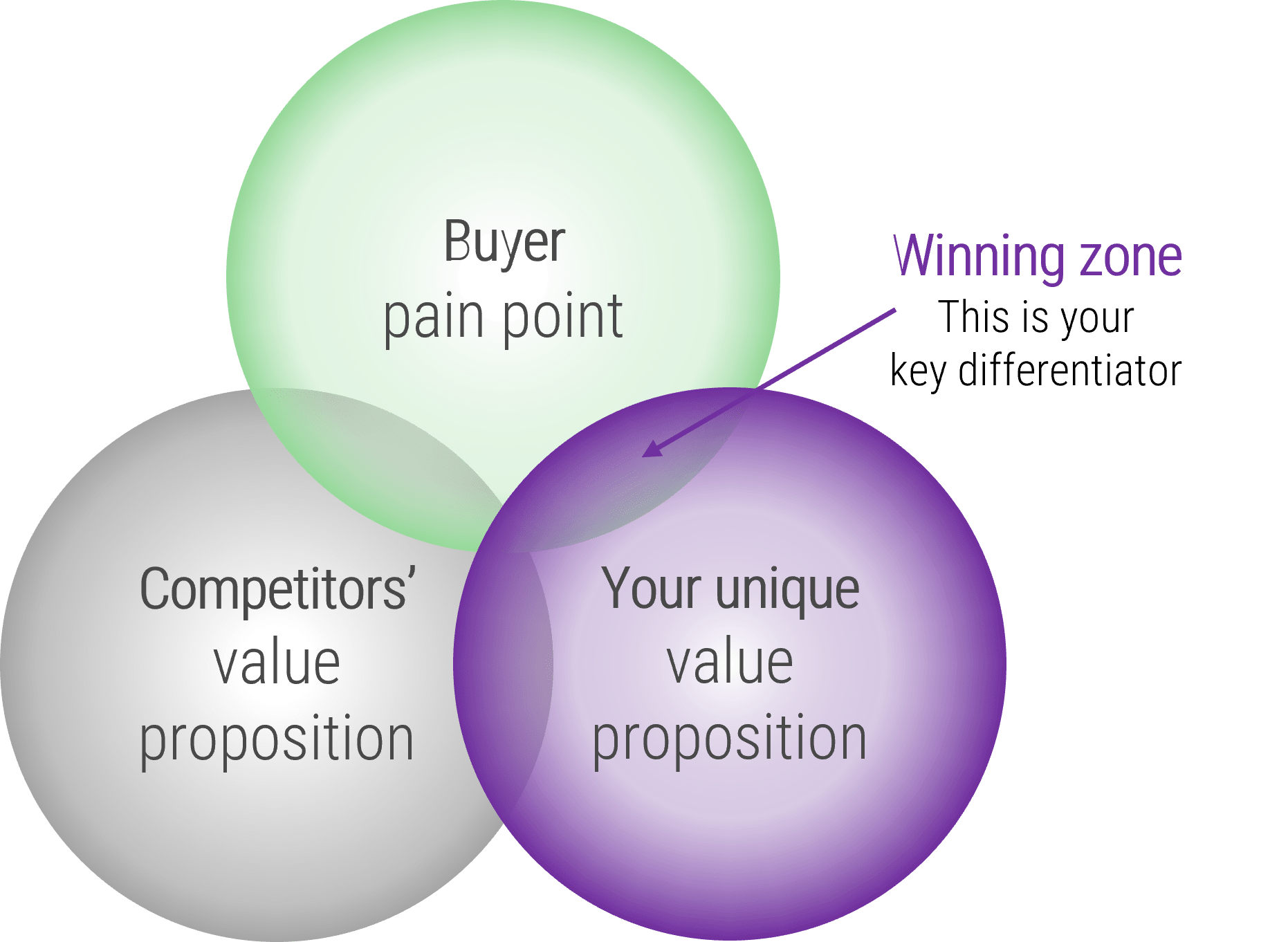
Give your brand a voice
Define and present a consistent voice across all channels and assets.
The voice reflects the personality of the brand and the emotion to be transmitted. That's why it's crucial to establish strict rules that define the language to use when communicating through the brand's voice, the type of words, and do's and don'ts.
To be recognizable it is imperative to avoid inconsistencies. No matter how many people are behind the brand voice, the brand must show a unique, distinctive personality. As for the tone, it may vary according to circumstances, from lighter to more serious.
Up to 80% Increased customer recognition when the brand uses a signature color scheme across multiple platforms
Source: startup Bonsai
23% of revenue increase is what consistent branding across channels leads to.
Source: Harvard Business Review
When we close our eyes and listen, we all recognize Ella Fitzgerald's rich and unique singing voice.
We expect to recognize the writing of Stephen King when we read his books. For the brand's voice, it's the same. People want to be able to recognize it.
Adopt a more human-centric approach
If your brand was a person, who would it be?
Human attributes
Physically attractive
- Brand identity
- Logo and tagline
- Product design
Intellectually stimulating
- Knowledge and ideas
- Continuous innovation
- Thought leadership
Sociable
- Friendly, likeable and fun
- Confidently engage with audience through multiple touchpoints
- Posts and shares meaningful content
- Responsive
Emotionally connected
- Inspiring
- Powerful influencer
- Triggers emotional reactions
Morally sound
- Ethical and responsible
- Value driven
- Deliver on its promise
Personable
- Honest
- Self-confident and motivated
- Accountable
0.05 Seconds is what it takes for someone to form an opinion about a website, and a brand.
Source: 8ways
90% of the time, our initial gut reaction to products is based on color alone.
Source: startup Bonsai
56% of the final b2b purchasing decision is based on emotional factors.
Source: B@B International
Put values at the heart of the brand-buyers relationship
Highlight values that will resonate with your audience.
Brands that focus on the values they share with their buyers, rather than simply on a product or service, succeed in making meaningful emotional connections with them and keep them actively engaged.
Shared values such as transparency, sustainability, diversity, environmental protection, and social responsibility become the foundation of a solid relationship between a brand and its audience.
The key is to know what motivates the target audience.
86% of consumers claim that authenticity is one of the key factors they consider when deciding which brands they like and support.
Source: Business Wire
56% of the final decision is based on having a strong emotional connection with the supplier.
Source: B2B International
64% of today's customers are belief-driven buyers; they want to support brands that "can be a powerful force for change."
Source: Edelman
"If people believe they share values with a company, they will stay loyal to the brand."
– Howard Schultz
Source: Lokus Design
Double-down on digital
Develop your digital presence and reach out to your target audiences through multiple touchpoints.
Beyond engaging content, reaching the target audience requires brands to connect and interact with their audience in multiple ways so that potential buyers can form an opinion.
With the right message consistently delivered across multiple channels, brands increase their reach, create a buzz around their brand and raise awareness.
73% of today's consumers confirm they use more than one channel during a shopping journey
Source: Harvard Business Review
Platforms
- Website and apps
- Social media
- Group discussions
Multimedia
- Webinars
- Podcasts
- Publication
Campaign
- Ads and advertising
- Landing pages
- Emails, surveys drip campaigns
Network
- Tradeshows, events, sponsorships
- Conferences, speaking opportunities
- Partners and influencers
Use social media to connect
Reach out to the masses with a social media presence.
Social media platforms represent a cost-effective opportunity for businesses to connect and influence their audience and tell their story by posting relevant and search-engine-optimized content regularly on their account and groups. It's also a nice gateway to their website.
Building a relationship with their target buyer through social media is also an easy way for businesses to:
- Understand the buyers.
- Receive feedback on how the buyers perceive the brand and how to improve it.
- Show great user experience and responsiveness.
- Build trust.
- Create awareness.
75% of B2B buyers and 84% of C-Suite executives use social media when considering a purchase
Source: LinkedIn Business
92% of B2B buyers use social media to connect with leaders in the sales industry.
Source: Techjury
With over 4.5 billion social media users worldwide, and 13 new users signing up to their first social media account every second, social media is fast becoming a primary channel of communication and social interaction for many.
Source: McKinsey
Become the expert subject matter
Raise awareness with thought leadership content.
Thought leadership is about building credibility
by creating and publishing meaningful, relevant content that resonates with a target audience.
Thought leaders write and publish all kinds of relevant content such as white papers, ebooks, case studies, infographics, video and audio content, webinars, and research reports.
They also participate in speaking opportunities, live presentations, and other high-visibility forums.
Well-executed thought leadership strategies contribute to:
- Raise awareness.
- Build credibility.
- Be recognized as a subject expert matter.
- Become an industry leader.
60% of buyers say thought leadership builds credibility when entering a new category where the brand is not already known.
Source: Edelman | LinkedIn
70% of people would rather learn about a company through articles rather than advertising.
Source: Brew Interactive
57% of buyers say that thought leadership builds awareness for a new or little-known brand.
Source: Edelman | LinkedIn
To achieve best results
- Know the buyers' persona and journey.
- Create original content that matches the persona of the target audience and that is close to their values.
- Be Truthful and insightful.
- Find the right tone and balance between being human-centric, authoritative, and bold.
- Be mindful of people's attention span and value their time.
- Create content for each phase of the buyer's journey.
- Ensure content is SEO, keyword-loaded, and add calls-to-action (CTAs).
- Add reason to believe, data to support, and proof points.
- Address the buyers' pain points in a unique way.
Avoid
- Focusing on product features and on selling.
- Publishing generic content.
- Using an overly corporate tone.
Promote personal branding
Rely on your most powerful brand ambassadors and influencers: your employees.
The strength of personal branding is amplified when individuals and companies collaborate to pursue personal branding initiatives that offer mutual benefits. By training and positioning key employees as brand ambassadors and industry influencers, brands can boost their brand awareness through influencer marketing strategies.
Personal branding, when well aligned with business goals, helps brands leverage their key employee's brands to:
- Increase the organization's brand awareness.
- Broaden their reach and circle of influence.
- Show value, gain credibility, and build trust.
- Stand out from the competition.
- Build employee loyalty and pride.
- Become a reference to other businesses.
- Increase speaking opportunities.
- Boost qualified leads and sales.
About 90% of organizations' employee network tends to be completely new to the brand.
Source: Everyone Social
8X more engagement comes from social media content shared by employees rather than brand accounts.
Source: Entrepreneur
561% more reach when brand messages are shared by employees on social media, than the same message shared by the Brand's social media.
Source: Entrepreneur
"Personal branding is the art of becoming knowable, likable and trustable."
Source: Founder Jar, John Jantsch
Invest in B2B influencer marketing
Broaden your reach and audiences by leveraging the voice of influencers.
Influencers are trusted industry experts and analysts who buyers can count on to provide reliable information when looking to make a purchase.
Influencer marketing can be very effective to reach new audiences, increase awareness, and build trust. But finding the right influencers with the level of credibility and visibility brands are expecting can sometimes be challenging.
Search for influencers that have:
- Relevance of audience and size.
- Industry expertise and credibility.
- Ability to create meaningful content (written, video, audio).
- Charismatic personality with values consistent with the brand.
- Frequent publications on at least one leading media platform.
76% of people say that they trust content shared by people over a brand.
Source: Adweek
44% increased media mention of the brand using B2B influencer marketers.
Source: TopRank Marketing
Turn your customers into brand advocates
Establish customer advocacy programs and deliver a great customer experience.
Retain your customers and turn them into brand advocates by building trust, providing an exceptional experience, and most importantly, continuously delivering on the brand promise.
Implement a strong customer advocacy program, based on personalized experiences, the value provided, and mutual exchange, and reap the benefits of developing and growing long-term relationships.
92% of individuals trust word-of-mouth recommendations, making it one of the most trust-rich forms of advertising.
Source: SocialToaster
Word-of-mouth (advocacy) marketing increases marketing effectiveness by 54%
Source: SocialToaster
Make your brand known and make it stick in people's minds
Building and maintaining high brand awareness requires that each individual within the organization carry and deliver the brand message clearly and consistently across all media whether in person, in written communications, or otherwise.
To achieve this, brand leaders must first develop a powerful, researched narrative that people will embrace and convey, which requires careful preparation.
Target market and audience intel
- Target market Intel
- Buyer persona and journey/pain points
- Uniqueness and positioning
Brand attributes
- Values at the heart of the relationship
- Brand's human attributes
Brand visibly and recall
- Digital and social media presence
- Thought leadership
- Personal branding
- Influencer marketing
Brand awareness building plan
- Long-term awareness and multi-touchpoint approach
- Monitoring and optimization
Short and long-term benefits of increasing brand awareness
Brands are built over the long term but the rewards are high.
- Stronger brand perception
- Improved engagement and brand associations
- Enhanced credibility, reputation, and trust
- Better connection with customers
- Increased repeat business
- High-quality leads
- Higher and faster conversion rate
- More sales closed/ deals won
- Greater brand equity
- Accelerated growth
"Strong brands outperform their less recognizable
competitors by as much as 73%."
Source: McKinsey
Brand awareness building
Building brand awareness, even though immediate benefits are often difficult to see and measure, is essential for companies to stand out from their competitors and continue to grow in a sustainable way.
To successfully raise awareness, brands need to have:
- A longer-term vision and strategy.
- Market Intelligence, a clear value proposition, and key differentiator.
- Consistent, well-aligned messaging and storytelling.
- Digital presence and content.
- The ability to reach out through multiple touchpoints.
- Necessary resources.
Without brand awareness, brands become less attractive to buyers, talent, and investors, and their ability to grow, increase their market value, and be sustainable is reduced.
Brand awareness building methodology
Define brands' personality and message
- Gather market intel and analyze the market.
- Determine the value proposition and positioning.
- Define the brand archetype and voice.
- Craft a compelling brand message and story.
- Get all the key elements of your brand guidelines.
Start building brand awareness
- Achieve strategy alignment and readiness.
- Create and manage assets.
- Deploy your tactics, assets, and workflows.
- Establish key performance indicators (KPIs).
- Monitor and optimize on an ongoing basis.
Toolkit
- Market and Influencing Factors Analysis
- Recognition Survey and Best Practices
- Buyer Personas and Journeys
- Purpose, Mission, Vision, Values
- Value Proposition and Positioning
- Brand Message, Voice, and Writing Style
- Brand Strategy and Tactics
- Asset Creation and Management
- Strategy Rollout Plan
Short and long-term benefits of increasing brand awareness
Increase:
- Brand perception
- Brand associations and engagement
- Credibility, reputation, and trust
- Connection with customers
- Repeat business
- Quality leads
- Conversion rate
- Sales closed / deals won
- Brand equity and growth
It typically takes 5-7 brand interactions before a buyer remembers the brand.
Source: Startup Bonsai
Who benefits from this brand awareness research?
This research is being designed for:
Brand and marketing leaders who:
- Know that brand awareness is essential to the success of all marketing and sales activities.
- Want to make their brand unique, recognizable, meaningful, and highly visible.
- Seek to increase their digital presence, connect and engage with their target audience.
- Are looking at reaching a new segment of the market.
This research will also assist:
- Sales with qualified lead generation and customer retention and loyalty.
- Human Resources in their efforts to attract and retain talent.
- The overall business with growth and increased market value.
This research will help you:
- Gain market intelligence and a clear understanding of the target audience's needs and trends, competitive advantage, and key differentiator.
- The ability to develop clear and compelling, human-centric messaging and compelling story driven by brand values.
- Increase online presence and brand awareness activities to attract and engage with buyers.
- Develop a long-term brand awareness strategy and deployment plan.
This research will help them:
- Increase campaign ROI.
- Develop a longer-term vision and benefits of investing in longer-term initiatives.
- Build brand equity and increase business valuation.
- Grow your business in a more sustainable way.
SoftwareReviews' brand awareness building methodology
Phase 1 Define brands' personality and message |
Phase 2 Start building brand awareness |
|
|---|---|---|
Phase steps |
1.1 Gather market intelligence and analyze the market. 1.2 Develop and document the buyer's persona and journey. 1.3 Uncover the brand mission, vision statement, core values, value proposition and positioning. 1.4 Define the brand's archetype and tone of voice, then craft a compelling brand messaging. |
2.1 Achieve strategy alignment and readiness. 2.2 Create assets and workflows and deploy tactics. 2.3 Establish key performance indicators (KPIs), monitor, and optimize on an ongoing basis. |
Phase outcomes |
|
|
Insight summary
Brands to adapt their strategies to achieve longer-term growth
Brands must adapt and adjust their strategies to attract informed buyers who have access to a wealth of products, services, and brands from all over. Building brand awareness, even though immediate benefits are often difficult to see and measure, has become essential for companies that want to stand out from their competitors and continue to grow in a sustainable way.
A more human-centric approach
Brand personalities matter. Brands placing human values at the heart of the customer-brand relationship will drive interest in their brand and build trust with their target audience.
Stand out from the crowd
Brands that develop and promote a clear and consistent message across all platforms and channels, along with a unique value proposition, stand out from their competitors and get noticed.
A multi-touchpoints strategy
Engage buyers with relevant content across multiple media to address their pain points. Analyze touchpoints to determine where to invest your efforts.
Going social
Buyers expect brands to be active and responsive in their interactions with their audience. To build awareness, brands are expected to develop a strong presence on social media by regularly posting relevant content, engaging with their followers and influencers, and using paid advertising. They also need to establish thought leadership through content such as white papers, case studies, and webinars.
Thought leaders wanted
To enhance their overall brand awareness strategy, organizations should consider developing the personal brand of key executives. Thought leadership can be a valuable method to gain credibility, build trust, and drive conversion. By establishing thought leadership, businesses can increase brand mentions, social engagement, website traffic, lead generation, return on investment (ROI), and Net Promoter Score (NPS).
Save time and money with SoftwareReviews' branding advice
Collaborating with SoftwareReviews analysts for inquiries not only provides valuable advice but also leads to substantial cost savings during branding activities, particularly when partnering with an agency.
| Guided Implementation | Purpose | Measured Value |
|---|---|---|
| Build brands' personality and message | Get the key elements of the brand guidelines in place and ready to use, along with your existing logo, typography, color palette, and imagery, to ensure consistency and clarity across all brand touchpoints from internal communication to customer-facing materials. | Working with SoftwareReviews analysts to develop brand guidelines saves costs compared to hiring an agency.
Example: Building the guidelines with an agency will take more or less the same amount of time and cost approximately $80K. |
| Start building brand awareness | Achieve strategy alignment and readiness, then deploy tactics, assets, and other deliverables. Start building brand awareness and reap the immediate and long-term benefits. | Working with SoftwareReviews analysts and your team to develop a long-term brand strategy and deployment will cost you less than a fraction of the cost of using an agency. Example: Developing and executing long-term brand awareness strategies with an agency will cost between $50-$75K/month over a 24-month period minimum. |
Guided Implementation
What does a typical GI on this topic look like?
Phase 1Build brands' personality and message |
Phase 2Start building brand awareness |
||
|---|---|---|---|
|
|
|
|
A Guided Implementation (GI) is a series of calls with a SoftwareReviews Marketing Analyst to help implement our best practices in your organization.
Your engagement managers will work with you to schedule analyst calls.
Brand awareness building tools
Each step of this blueprint comes with tools to help you build brand awareness.
Brand Awareness Tool Kit
This kit includes a comprehensive set of tools to help you better understand your target market and buyers, define your brand's personality and message, and develop an actionable brand awareness strategy, workflows, and rollout plan.
The set includes these templates:
|
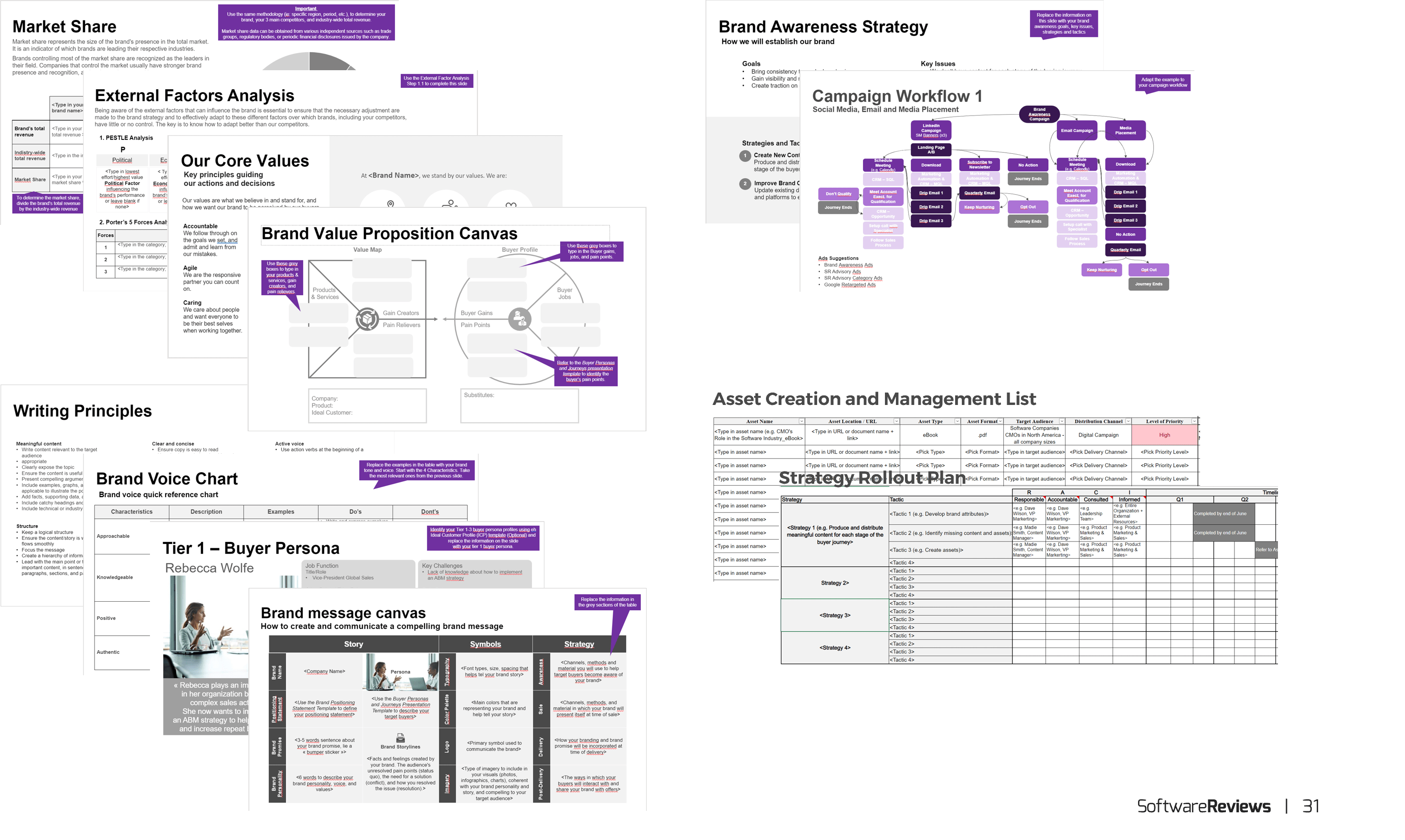 |
Get started!
Know your target market and audience, deploy well-designed strategies based on shared values, and make meaningful connections with people.
Phase 1
Define brands' personality and message
Phase 2
Start building brand awareness
Phase 1
Define brands' personality and message
Steps
1.1 Gather market intelligence and analyze the market.
1.2 Develop and document the buyer's persona and journey.
1.3 Uncover the brand mission, vision statement, core values, positioning, and value proposition.
1.4 Define the brand's archetype and tone of voice, then craft a compelling brand messaging.
Phase outcome
- Target market and audience are identified and documented.
- A clear value proposition and positioning are determined.
- The brand personality, voice, and messaging are developed.
- All the key elements of the brand guidelines are in place. and ready to use, along with the existing logo, typography, color palette, and imagery..
Build brands' personality and message
Step 1.1 Gather market intelligence and analyze the market.
Total duration: 2.5-8 hours
Objective
Analyze and document your competitive landscape, assess your strengths, weaknesses, opportunities,
and threats, gauge the buyers' familiarity with your brand, and identify the forces of influence.
Output
This exercise will allow you to understand your market and is essential to developing your value proposition.
Participants
- Head of branding and key stakeholders
MarTech
May require you to:
- Register to a Survey Platform.
- Use, setup, or install platforms like CRM and/or Marketing Automation Platform.
Tools
- Market Analysis Template
- Brand Recognition Survey Questionnaire and List Template and Survey Emails Best Practices Guidelines
- External and Internal Factors Analysis Template
1.1.1 SWOT and competitive landscape (60-120 min.) |
|
|---|---|
Analyze & Document |
Follow the instructions in the Market Analysis Template to complete the SWOT and Competitive Analysis, slides 4 to 7. |
1.1.3 Internal and External Factors (30-60 min.) |
|
|---|---|
Analyze |
Follow the instructions in the External and Internal Factors Analysis Template to perform the PESTLE, Porter's 5 Forces, and Internal Factors and VRIO Analysis. |
Transfer |
Transfer key information into slides 10 and 11 of the Market Analysis Template. |
Consult SoftwareReviews website to find the best survey and MarTech platforms or contact one of our analysts for more personalized assistance and guidance
1.1.2 Brand recognition (60-300 min.) |
|
|---|---|
Prep |
Adapt the survey and interview questions in the Brand Recognition Survey Questionnaire and List Template. Determine how you will proceed to conduct the survey and interviews (internal or external resources, and tools). Refer to the Survey Emails Best Practices Guidelines for more information on how to conduct email surveys. |
Collect & Analyze |
Use the Brand Recognition Survey Questionnaire and List Template to build your list, conduct the survey /interviews, and collect and analyze the feedback received. |
Transfer |
Transfer key information into slides 8 and 9 of the Market Analysis Template. |
Brand performance diagnostic
Have you considered diagnosing your brand's current performance before you begin building brand awareness?
Audit your brand using the Diagnose Brand Health to Improve Business Growth blueprint.Collect and interpret qualitative and quantitative brand performance measures.
The toolkit includes the following templates:
- Surveys and interviews questions and lists
- External and internal factor analysis
- Digital and financial metrics analysis
Also included is an executive presentation template to communicate the results to key stakeholders and recommendations to fix the uncovered issues.
Build brands' personality and message
Step 1.2 Develop and document the buyer's persona and journey.
Total duration: 4-8 hours
Objective
Gather existing and desired customer insights and conduct market research to define and personify your buyers' personas and their buying behaviors.
Output
Provide people in your organization with clear direction on who your target buyers are and guidance on how to effectively reach and engage with them throughout their journey.
Participants
- Head of branding
- Key stakeholders from sales and product marketing
MarTech
May require you to:
- Register to an Online Survey Platform (free version or subscription).
- Use, setup, or installation of platforms like CRM and/or Marketing Automation Platform.
Tools
- Buyer Personas and Journeys Presentation Template
- Ideal Customer Profile (ICP) Workbook
- Buyer Persona and Journey Interview Guide and Data Capture
1.2.1 Buyer Personas and Journeys (240-280 min.) |
|
|---|---|
Research |
Identify your tier 1 to 3 customers using the Ideal Client Profile (ICP) Workbook. (Recommended) Survey and interview existing and desired customers based using the Buyer Persona and Journey Interview Guide and Data Capture Tool. (Recommended) |
Create |
Define and document your tier 1 to 3 Buyer Personas and Journeys using the Buyer Personas and Journeys Presentation Template. |
Consult SoftwareReviews website to find the best survey platform for your needs or contact one of our analysts for more personalized assistance and guidance
Buyer Personas and Journeys
A well-defined buyer persona and journey is a great way for brands to ensure they are effectively reaching and engaging their ideal buyers through a personalized buying experience.
When properly documented, it provides valuable insights about the ideal customers, their needs, challenges, and buying decision processes allowing the development of initiatives that correspond to the target buyers.
Build brands' personality and message
Step 1.3 Uncover the brand mission, vision statement, core values, value proposition, and positioning.
Total duration: 4-5.5 hours
Objective
Define the "raison d'être" and fundamental principles of your brand, your positioning in the marketplace, and your unique competitive advantage.
Output
Allows everyone in an organization to understand and align with the brand's raison d'être beyond the financial dimension, its current positioning and objectives, and how it intends to achieve them.
It also serves to communicate a clear and appealing value proposition to buyers.
Participants
- Head of branding
- Chief Executive Officer (CEO)
- Key stakeholders
Tools
- Brand Purpose, Mission, Vision, and Values Template
- Value Proposition and Positioning Statement Template
1.3.1 Brand Purpose, Mission, Vision, and Values (90-120 min.) |
|
|---|---|
Capture or Develop |
Capture or develop, if not already existing, your brand's purpose, mission, vision statement, and core values using slides 4 to 7 of the Brand Purpose, Mission, Vision, and Values Template. |
1.3.2 Brand Value Proposition and Positioning (150-210 min.) |
|
|---|---|
Define |
Map the brand value proposition using the canvas on slide 5 of the Value Proposition and Positioning Statement Template, and clearly articulate your value proposition statement on slide 4. Optional: Use canvas on slide 7 to develop product-specific product value propositions. On slide 8 of the same template, develop your brand positioning statement. |
Build brands' personality and message
Steps 1.4 Define the brand's archetype and tone of voice, and craft a compelling brand messaging.
Total duration: 5-8 hours
Objective
Define your unique brand voice and develop a set of guidelines, brand story, and messaging to ensure consistency across your digital and non-digital marketing and communication assets.
Output
A documented brand personality and voice, as well as brand story and message, will allow anyone producing content or communicating on behalf of your brand to do it using a unique and recognizable voice, and convey the right message.
Participants
- Head of branding
- Content specialist
- Chief Executive Officer and other key stakeholders
Tools
- Brand Voice Guidelines Template
- Writing Style Guide Template
- Brand Messaging Template
- Writer Checklist Template
1.4.1 Brand Archetype and Tone of Voice (120-240 min.) |
|
|---|---|
Define and document |
Refer to slides 5 and 6 of the Brand Voice Guidelines Template to define your brand personality (archetype), slide 7. Use the Brand Voice Guidelines Template to define your brand tone of voice and characteristics on slides 8 and 9, based on the 4 primary tone of voice dimensions, and develop your brand voice chart, slide 9. |
Set Rules |
In the Writing Style Guide template, outline your brand's writing principles, style, grammar, punctuation, and number rules. |
1.4.2 Brand Messaging (180-240 min.) |
|
|---|---|
Craft |
Use the Brand Messaging template, slides 4 to 7, to craft your brand story and message. |
Audit |
Create a content audit to review and approve content to be created prior to publication, using the Writer's Checklist template. |
Important Tip!
A consistent brand voice leads to remembering and trusting the brand. It should stand out from the competitors' voices and be meaningful to the target audience. Once the brand voice is set, avoid changing it.
Phase 2
Start building brand awareness
Steps
2.1 Achieve strategy alignment and readiness.
2.2 Create assets and workflows, and deploy tactics.
2.3 Establish key performance indicators (KPIs), monitor, and optimize on an ongoing basis.
Phase outcome
- A comprehensive and actionable brand awareness strategy, with tactics, KPIs, and metrics, is set and ready to execute.
- A progressive and effective deployment plan with deliverables, timelines, workflows, and checklists is in place.
- Resources are assigned.
Start building brand awareness
Step 2.1 Achieve strategy readiness and alignment.
Total duration: 4-5 hours
Objective
Now that you have all the key elements of your brand guidelines in place, in addition to your existing logo, typography, color palette, and imagery, you can begin to build brand awareness.
Start planning to build brand awareness by developing a comprehensive and actionable brand awareness strategy with tactics that align with the company's purpose and objectives. The strategy should include achievable goals and measurables, budget and staffing considerations, and a good workload assessment.
Output
A comprehensive long-term, actionable brand awareness strategy with KPIs and measurables.
Participants
- Head of branding
- Key stakeholders
Tools
- Brand Awareness Strategy and Tactics Template
2.1.1 Brand Awareness Analysis (60-120 min.) | |
|---|---|
Identify | In slide 5 of the Brand Awareness Strategy and Tactics Template, identify your top three brand awareness drivers, opportunities, inhibitors, and risks to help you establish your strategic objectives in building brand awareness. |
2.1.2 Brand Awareness Strategy (60-120 min.) | |
|---|---|
Elaborate | Use slides 6 to 10 of the Brand Awareness Strategy and Tactics Template to elaborate on your strategy goals, key issues, and tactics to begin or continue building brand awareness. |
2.1.3 Brand Awareness KPIs and Metrics (180-240 min.) |
|
|---|---|
Set |
Set the strategy performance metrics and KPIs on slide 11 of the Brand Awareness Strategy and Tactics Template. |
Monitor |
Once you start executing the strategy, monitor and report each quarter using slides 13 to 15 of the same document. |
Understanding the difference between strategies and tactics
Strategies and tactics can easily be confused, but although they may seem similar at times, they are in fact quite different.
Strategies and tactics are complementary.
A strategy is a plan to achieve specific goals, while a tactic is a concrete action or set of actions used to implement that strategy.
To be effective, brand awareness strategies should be well thought-out, carefully planned, and supported by a series of tactics to achieve the expected outcomes.
Start building brand awareness
Step 2.2 Create assets and workflows and deploy tactics.
Total duration: 3.5-4.5 hours
Objective
Build a long-term rollout with deliverables, milestones, timelines, workflows, and checklists. Assign resources and proceed to the ongoing development of assets. Implement, manage, and continuously communicate the strategy and results to key stakeholders.
Output
Progressive and effective development and deployment of the brand awareness-building strategy and tactics.
Participants
- Head of branding
Tools
- Asset Creation and Management List
- Campaign Workflows Template
- Brand Awareness Strategy Rollout Plan Template
2.2.1 Assets Creation List (60-120 min.) | |
|---|---|
Inventory | Inventory existing assets to create the Asset Creation and Management List. |
Assign | Assign the persons responsible, accountable, consulted, and informed of the development of each asset, using the RACI model in the template. Ensure you identify and collaborate with the right stakeholders. |
Prioritize | Prioritize and add release dates. |
Communicate | Update status and communicate regularly. Make the list with links to the assets available to the extended team to consult as needed. |
2.2.2 Rollout Plan (60-120 min.) | |
|---|---|
Inventory | Map out your strategy deployment in the Brand Awareness Strategy Rollout Plan Template and workflow in the Campaign Workflow Template. |
Assign | Assign the persons responsible, accountable, consulted, and informed for each tactic, using the RACI model in the template. Ensure you identify and collaborate with the right stakeholders. |
Prioritize | Prioritize and adjust the timeline accordingly. |
Communicate | Update status and communicate regularly. Make the list with links to the assets available to the extended team to consult as needed. |
Band Awareness Strategy Rollout Plan
A strategy rollout plan typically includes the following:
- Identifying a cross-functional team and resources to develop the assets and deploy the tactics.
- Listing the various assets to create and manage.
- A timeline with key milestones, deadlines, and release dates.
- A communication plan to keep stakeholders informed and aligned with the strategy and tactics.
- Ongoing performance monitoring.
- Constant adjustments and improvements to the strategy based on data collected and feedback received.
Start building brand awareness
Step 2.3 Establish key performance indicators (KPIs), monitor, and optimize on an ongoing basis.
Total duration: 3.5-4.5 hours
Objective
Brand awareness is built over a long period of time and must be continuously monitored in several ways. Measuring and monitoring the effectiveness of your brand awareness activities will allow you to constantly adjust your tactics and continue to build awareness.
Output
This step will provide you with a snapshot of your current level of brand awareness and interactions with the brand, and allow you to set up the tools for ongoing monitoring and optimization.
Participants
- Head of branding
- Digital marketing manager
MarTech
May require you to:
- Register to an Online Survey Platform(free version or subscription), or
- Use, setup, or installation of platforms like CRM and/or Marketing Automation Platform.
- Use Google Analytics or other tracking tools.
- Use social media and campaign management tools.
Tools
- Brand Awareness Strategy and Tactics Template
2.2.2 Rollout Plan (60-120 min.) | |
|---|---|
Measure | Monitor and record the strategy performance metrics in slides 12 to 15 of the Brand Awareness Strategy and Tactics template, and gauge its performance against preset KPIs in slide 11. Make ongoing improvements to the strategy and assets. |
Communicate | The same slides in which you monitor strategy performance can be used to report on the results of the current strategy to key stakeholders on a monthly or quarterly basis, as appropriate. Take this opportunity to inform stakeholders of any adjustments you plan to make to the existing plan to improve its performance. Since brand awareness is built over time, be sure to evaluate the results based on how long the strategy has been in place before making major changes. |
Consult SoftwareReviews website to find the best survey, brand monitoring and feedback, and MarTech platforms, or contact one of our analysts for more personalized assistance and guidance
Measuring brand strategy performance
There are two ways to measure and monitor your brand's performance on an ongoing basis.
- By registering to brand monitoring and feedback platforms and tools like Meltwater, Hootsuite, Insights, Brand24, Qualtrics, and Wooltric.
- Manually, using native analytics built in the platforms you're already using, such as Google and Social Media Analytics, or by gathering customer feedback through surveys, or calculating CAC, ROI, and more in spreadsheets.
SoftwareReviews can help you choose the right platform for your need. We also equip you with manual tools, available with the Diagnose Brand Health to Improve Business Growthblueprint to measure:
- Surveys and interviews questions and lists.
- External and internal factor analysis.
- Digital and financial metrics analysis.
- Executive presentation to report on performance.
Related SoftwareReviews research
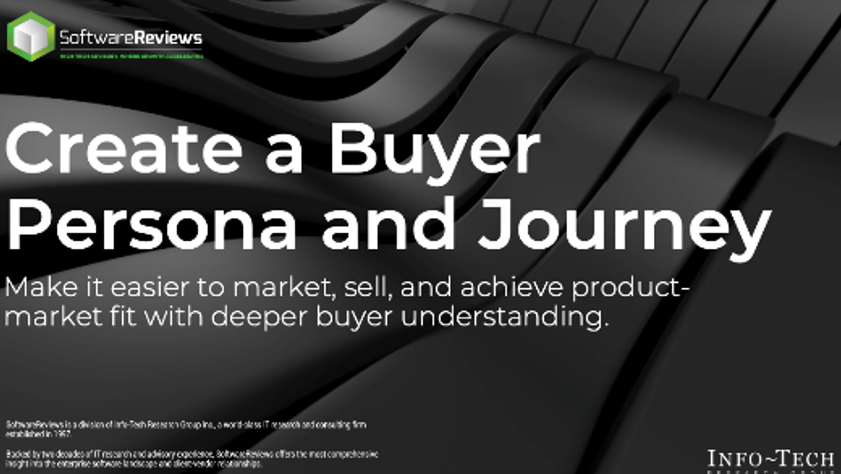 |
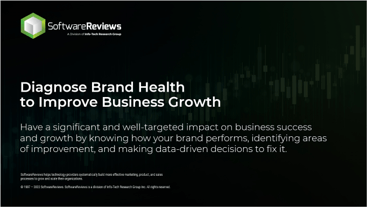 |
Create a Buyer Persona and Journey Get deeper buyer understanding and achieve product-market fit, with easier access to market and sales
|
Diagnose Brand Health to Improve Business Growth Have a significant and well-targeted impact on business success and growth by knowing how your brand performs, identifying areas of improvement, and making data-driven decisions to fix them.
|
Bibliography
Aaker, David. "Managing Brand Equity." Simon & Schuster, 1991.
"6 Factors for Brands to Consider While Designing Their Communication." Lokus Design, 23 Sept. 2022.
"20 Advocacy Marketing Statistics You Need to Know." Social Toaster, n.d.
Bazilian, Emma. "How Millennials and Baby Boomers Consume User-Generated Content And what brands can learn from their preferences." Adweek, January 2, 2017.
B2B International, a Gyro: company, B2B Blog - Why Human-To-Human Marketing Is the Next Big Trend in a Tech-Obsessed World.
B2B International, a Gyro: company, The State of B2B Survey 2019 - Winning with Emotions: How to Become Your Customer's First Choice.
Belyh, Anastasia. "Brand Ambassador 101:Turn Your Personal Brand into Cash." Founder Jar, December 6, 2022.
Brand Master Academy.com.
Businesswire, a Berkshire Hathaway Company, "Stackla Survey Reveals Disconnect Between the Content Consumers Want & What Marketers Deliver." February 20, 2019.
Chamat, Ramzi. "Visual Design: Why First Impressions Matter." 8 Ways, June 5, 2019.
Cognism. "21 Tips for Building a LinkedIn Personal Brand (in B2B SaaS)."
Curleigh, James. "How to Enhance and Expand a Global Brand." TED.
"2019 Edelman Trust Barometer." Edelman.
Erskine, Ryan. "22 Statistics That Prove the Value of Personal Branding." Entrepreneur, September 13, 2016.
Forbes, Steve. "Branding for Franchise Success: How To Achieve And Maintain Brand Consistency Across A Franchise Network?" Forbes, 9 Feb. 2020.
Godin, Seth. "Define: Brand." Seth's Blog, 30 Dec. 2009,
Houragan, Stephen. "Learn Brand Strategy in 7 Minutes (2023 Crash Course)." YouTube.
Jallad, Revecka. "To Convert More Customers, Focus on Brand Awareness." Forbes, October 22, 2019.
Kingsbury, Joe, et al. "2021 B2B Thought Leadership Impact Study." Edelman, 2021.
Kunsman, Todd. "The Anatomy of an Employee Influencer." EveryoneSocial, September 8, 2022.
Landor, Walter. A Brand New World: The Fortune Guide to the 21st Century. Time Warner Books, 1999.
Liedke, Lindsay. "37+ Branding Statistics For 2023: Stats, Facts & Trends." Startup Bonsai, January 2, 2023.
Millman, Debbie. "How Symbols and Brands Shape our Humanity." TED, 2019.
Nenova, Velina. "21 Eye-Opening B2B Marketing Statistics to Know in 2023." Techjury, February 9, 2023.
Perrey, Jesko et al., "The brand is back: Staying relevant in an accelerating age." McKinsey & Company, May 1, 2015.
Schaub, Kathleen. "Social Buying Meets Social Selling: How Trusted Networks Improve the Purchase Experience." LinkedIn Business, April 2014.
Sopadjieva, Emma et al. "A Study of 46,000 Shoppers Shows That Omnichannel Retailing Works." Harvard Business Review, January 3, 2017.
Shaun. "B2B Brand Awareness: The Complete Guide 2023." B2B House. 2023.
TopRank Marketing, "2020 State of B2B Influencer Marketing Research Report." Influencer Marketing Report.